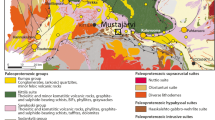Abstract
The East Uralian Zone south of Cheljabinsk consists of a Silurian to Early Carboniferous volcanosedimentary sequence on Proterozoic basement, intruded by postorogenic Permian granitic rocks. The 7 by 1–2 km Bereznjakovskoje gold trend is hosted by dacitic to andesitic volcanic-subvolcanic units of Late Devonian age. Epithermal gold mineralization is of the sulfide-rich low-sulfidation (adularia-sericite) type with the metal spectrum of Au-Ag-As-Sb-Cu-Zn-Pb and a characteristic Te component. Silicic and sericitic alteration overprints barren propylitic pyrite-rich assemblages in stockworks and shear zones. Precious-metal mineralization is related to a fahlore-telluride stage overprinting earlier pyrite. Late stage redistribution and weathering liberates gold from telluride mineral phases with fixation of native gold (high fineness) on vugs and grain boundaries, and in intergrowth aggregates with supergene jarosite/limonite. Epithermal mineralization formed below the boiling level and is possibly related to a porphyry system at depth.
Similar content being viewed by others
Author information
Authors and Affiliations
Additional information
Received: 23 February 1998 / Accepted: 12 July 1998
Rights and permissions
About this article
Cite this article
Lehmann, B., Heinhorst, J., Hein, U. et al. The Bereznjakovskoje gold trend, southern Urals, Russia. Mineral. Deposita 34, 241–249 (1999). https://doi.org/10.1007/s001260050201
Issue Date:
DOI: https://doi.org/10.1007/s001260050201




